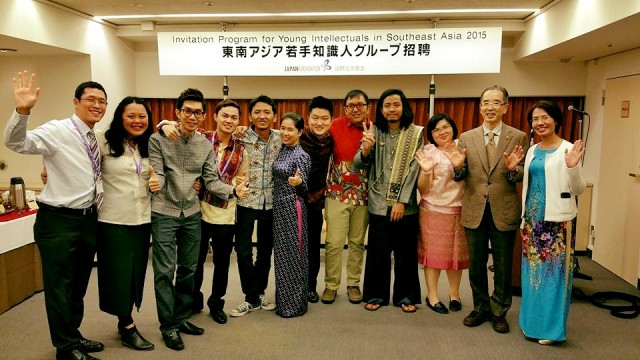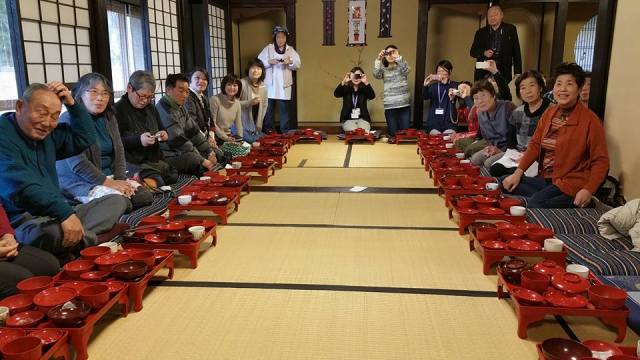
From left most Mr Ku Ka Leung with the Southeast Asian Young Intellectuals Group (Photo by Mr Tan Szue Hann)
Japan is currently facing serious issues of rapid population decline and aging population, and the Japanese government has identified the revitalization of rural areas in Japan as a key factor in overcoming these challenges. To promote intellectual exchange on the theme of "Revitalization of Rural Areas and Creation of New Values", the Japan Foundation organized the Invitation Program for Young Intellectuals in Southeast Asia, inviting me and 10 other young researchers and professionals from Southeast Asia to attend seminars and a field trip (to Noto Peninsula, Ishikawa Prefecture) in Japan from December 9th to 18th, 2015. The Program, though short in duration, has left a deep and lasting impression on me and other participants. In this article, I would like to share my key takeaways from the seminars and field trip.
The importance of revitalizing non-urban areas in Japan
Over the course of the Program, I, along with other participants from Malaysia, Indonesia, Vietnam, Thailand, and the Philippines, attended numerous seminars conducted by government officials, university professors, entrepreneurs and other professionals. One main theme emphasized in these seminars was the population imbalance between urban and non-urban areas and its relationship with Japan's population decline. According to a report ("Strategies to Stop Birthrate Decline and Vitalize Local Areas") released by the Japan Policy Council, young people are moving from non-urban areas to urban areas (especially metropolitan areas such as Tokyo, Nagoya and Osaka) to seek higher education and employment, and in urban areas the total fertility rate is generally lower than in rural areas.
There is therefore a great disparity between non-urban and urban areas in terms of youth population, resulting in lower fertility rates and depopulation in non-urban areas. Coupled with the ultra-low fertility rate in urban areas, this has led to a decline in Japan's population as a whole, which will affect Japan's economic strength and productivity in the long run. The revitalization of non-urban areas is therefore an important part of the solution to Japan's demographic challenges. Current government initiatives include the creation of employment, promotion of resettlement and provision of support for childbirth and child rearing in non-urban areas.
It is important, however, to note that government-led revitalization initiatives have their limitations. In his seminar on the status of regional revitalization in Japan, Professor Takaho Ueda of Gakushuin University pointed out that in some regions, local governments have tried to attract investment from industries outside their regions by offering them subsidies, cheap land and facilities. However, this model of revitalization is not sustainable due to intense competition amongst local governments. Professor Ueda suggested that in order to achieve sustainable regional revitalization, regional small and medium-sized companies need to develop a brand based on their region's unique characteristics and create 6th sector industries in which primary, secondary and tertiary industries are vertically integrated. The creation of a successful regional brand requires a good understanding of the region's unique characteristics and close cooperation between various parties in the region, such as local companies, local business associations, universities, think-tanks and local governments.
Discovering and promoting the attractiveness of Japan's regions
During the field trip to Noto Peninsula in Ishikawa Prefecture, I also learned about how local governments, universities and local communities are working together on rural revitalization initiatives that take advantage of Ishikawa Prefecture's characteristics. 60% of Ishikawa Prefecture is made up of Satoyama (regions of agriculture and forestry) and Satoumi (coastal and marine regions that are closely linked to the livelihoods of local inhabitants), and Noto Peninsula in particular has been certified as a Globally Important Agricultural Heritage System (GIAHS) by the Food and Agriculture Organization of the United Nations (FAO). Ishikawa Prefecture is also home to many institutions of higher education.
Taking into account these regional characteristics, the Ishikawa Prefectural Government has been encouraging closer cooperation between local communities and institutions of higher education, so as to tap on higher education institutions' ideas regarding the rediscovery and utilization of the charms of the region for rural revitalization. Successful projects include the Sawano Gobo (Burdock) project in Sawano District, Nanao City, which was supported by University Consortium Ishikawa (an association of higher education institutions in Ishikawa) from 2006 to 2008.
Since 2006, Kanazawa University has also been collaborating with locals in Noto Peninsula to implement the "Satoyama Satoumi Project", which is led by Professor Koji Nakamura. This project includes an initiative named "Noto Satoyama Meister Training Program", which is aimed at training young professionals up to 45 years of age to start up businesses related to agriculture, forestry and fishery. There are currently 128 "Meisters" active in Noto Peninsula, and it is hoped that their efforts will build the Noto brand, promote eco-tourism, and stimulate exchange between urban and rural areas, thus leading to revitalization of Noto Peninsula in the long run.
The field trip also gave me an opportunity to visit local businesses in Noto Peninsula, such as an organic vegetable farm (Vejoule LLC.), a farm stay operator (Shunran no Sato), a lacquer ware workshop (Kirimoto Wooden Craft Workshop), a winery and restaurant (OkuruSky Co., Ltd), etc. Although most of the owners of these businesses admitted that life in Noto Peninsula can be challenging and hard, but they also seemed to derive a sense of achievement and meaning from their hard work. I was awed by the energy, passion and determination they displayed when they talked about their lifestyles and businesses.
Certain locals also displayed impressive leadership and resourcefulness in organizing revitalization projects for their community, such as Mrs Kayoko Murotani and Mr Masamitsu Hoshino, whom I met at a lunch event promoting Noto Peninsula's local cuisine. Mrs Murotani and Mr Hoshino were instrumental in the founding of the "Notohantou no Uchigohan" project, which aims to preserve and promote Noto's traditional cuisine through the organization of monthly dining events in different parts of Noto, featuring seasonal and unique traditional cuisines from each locality. Not only was I impressed by the delicious cuisine served at the lunch event, but I was also touched by the warmth and hospitality displayed by the locals participating in the event. It struck me that the attractiveness of Noto Peninsula lies not only in its Satoyama and Satoumi, but also in the warmth and kindness of its people.
The need for constant networking, exchange and interaction
I have learnt a lot about rural revitalization in Japan through this Program and am thankful towards the Japan Foundation for giving me this valuable opportunity. Based on what I observed during my stay in Noto Peninsula, it seems that rural communities in Japan face complex demographic and economic challenges that need to be addressed from multiple angles. Thus, revitalization of rural areas will only be effective if there is close cooperation and coordination between the public and private sectors, and there is a need for academics, professionals, government officials and members of rural communities to constantly interact and exchange ideas with one another. Also, foreigners outside Japan are in general more familiar with Japan's metropolitan areas, and I think this needs to be addressed.
Most of my fellow Program participants had never been to rural areas in Japan before the Program, but they fell in love with the beauty of Noto Peninsula's landscape, culture and people. I hope that the Japan Foundation and other organizations can continue to organize similar exchange programs, so as to inspire more people around the world to interact and exchange ideas on how to sustain Japan's rural communities and their environments. |






